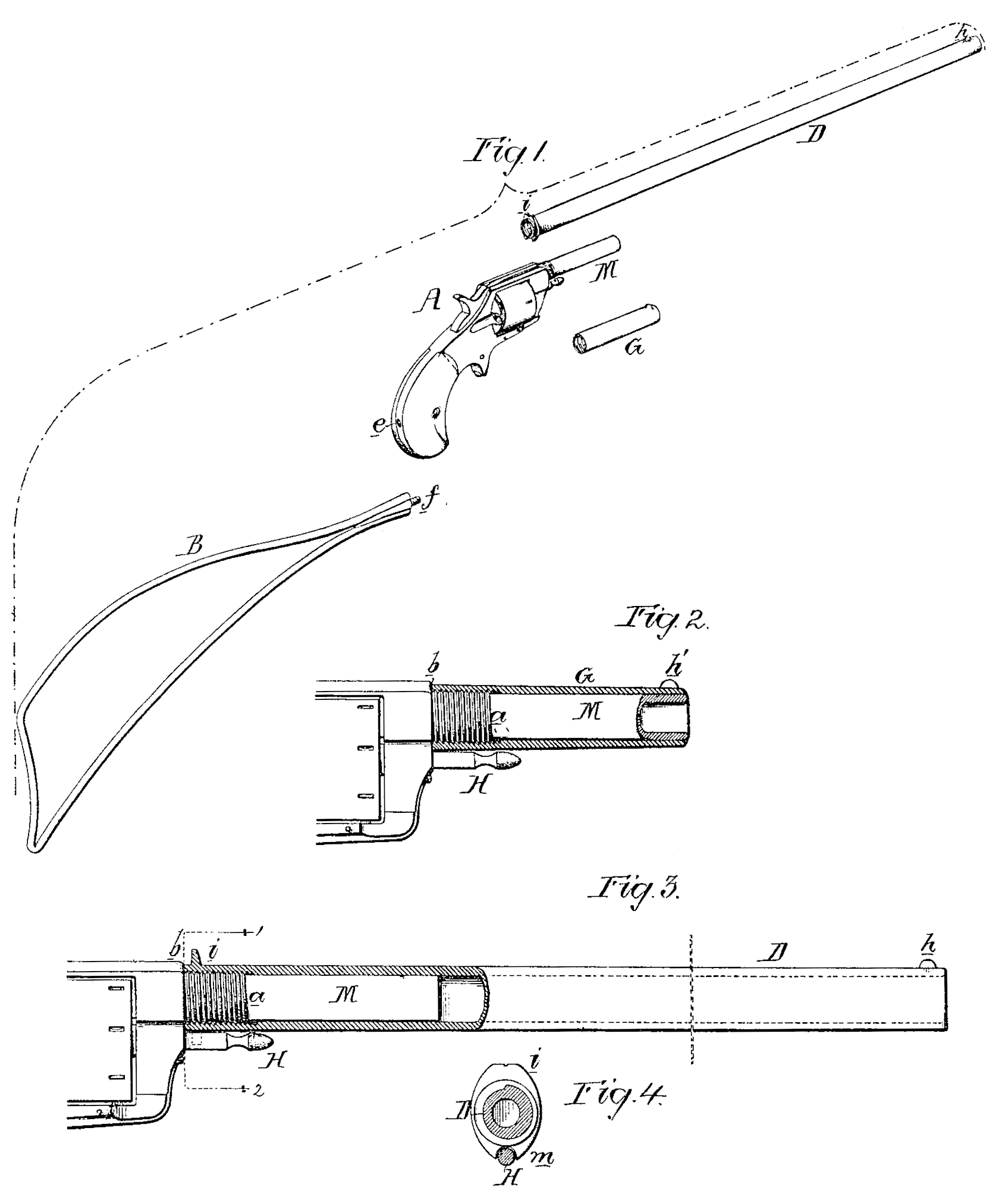US 183993
UNITED STATES PATENT OFFICE.
THOMAS M, WALLIS, OF PHILADELPHIA, PENNSYLVANIA, ASSIGNOR OF ONE-HALF HIS RIGHT TO WILLIAM WURFFLEIN, OF SAME PLACE.
IMPROVEMENT IN SUPPLEMENTARY BARRELS FOR REVOLVERS.
Specification forming part of Letters Patent No. 183,993, dated October 31, 1876; application filed October 19, 1876.
To all whom it may concern:
Be it, known that I, Thomas M. Wallis, of Philadelphia, Pennsylvania, have invented an Improvement in Fire-Arms, of which the following is a specification:
The object of my invention is to render a revolver available for long-range pistol or rifle practice, without detracting from its utility as an ordinary revolver; and this object I attain in the manner which I will now proceed to describe, reference being had to the accompanying drawing, in which—
Figure 1 is a perspective view, showing the different parts required in carrying out my invention; Fig. 2, a view of part of the fire-arm when arranged for use as an ordinary revolve; Fig. 3, part of the fire-arm arranged for rifle practice, and Fig. 4 a section on the line 12 of the supplemental barrel, (Shown in Fig. 3.)
The revolver A differs from those of ordinary construction in three respects only, the first being the absence from the end of the barrel of the usual projecting sight; the second is the formation on the main barrel M of the threaded enlargement a extending a short distance from the end b of the frame; and the third is a threaded orifice, e, in the handle, for receiving the threaded end f of the skeleton-stock B, of the shape or approximating to the shape of an ordinary rifle-stock.
When the weapon has to be arranged for rifle practice, a long tube or supplementary barrel, D, threaded internally at the rear end, is screwed onto the threaded enlargement a of the barrel M. The outer end of the tube D is furnished with a sight, h, properly arranged, in connection with the sight. i, for long-range practice.
I prefer to lock the tube or supplementary barrel D to the frame of the revolver by means of the base-pin H, in the manner shown in Figs. 3 and 4, the tube having on the under side a projection, In, in which is a recess adapted to the base-pin, which thus serves as a lock to maintain the supplementary barrel in its proper position.
Before the barrel can be unscrewed from the ordinary barrel it will be necessary to with draw the base-pin. In like manner the latter must be detached before the supplementary barrel can be re-attached to the main barrel. When the long supplementary barrel is thus secured to the revolver, the weapon may be used for long range pistol practice; or, by connecting the skeleton rifle-stock B. to that of the pistol, the weapon may be used as an ordinary rifle.
When the weapon has to be used as a revolver, a short supplementary barrel, G, carrying at its outer end the usual sight h’, may be screwed onto the threaded enlargement a as shown in Fig. 2.
It is not essential that the supplementary barrels should be secured to the main barrel by a screw-thread, as other well-known modes of attachment— the ordinary well-known bayonet-joint, for instance— may be employed for the purpose, although I prefer the screw-thread.
I claim as my invention—
1. The combination of a revolver with a detachable tube or supplementary barrel, D, adapted to the main barrel M, all substantially as and for the purpose set forth.
2. The combination of a revolver, the detachable supplementary barrel D, provided with a stop or sight, h, and the breech-pin H, adapted to a recess in the said barrel, all substantially as specified.
In testimony whereof I have signed my name to this specification in the presence of two subscribing witnesses.
T. M. WALLIS.
Witnesses:
Hermann Moessner,
Harry Smite.

